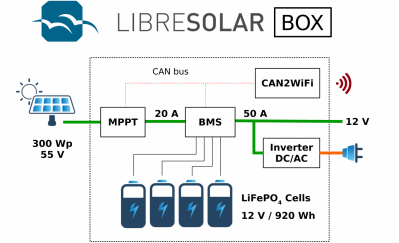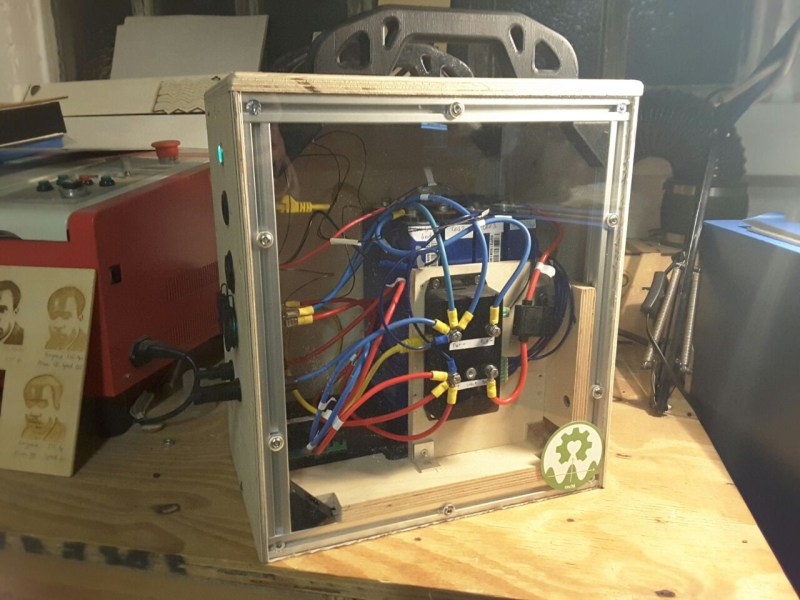Anyone tackling solar power for the first time will quickly find there’s a truly dizzying amount of information to understand and digest. You might think you just need to buy some solar panels, wire them together, and just sort of plug them in. But there are a hundred and one different questions about how they’ll be connected, the voltage of the panels, and the hardware for driving a load. [Michel], [case06], and [Martin Jäger] have set out to create a simpler and easier to understand charge controller named LibreSolar.

A charge controller is fundamentally a simple idea. The goal is to charge a battery with solar panels, which means it’s essentially just a heavy-duty DC/DC buck converter. What makes this project different is that it is an open platform built for extensibility.
There are UEXT connectors included for adding extra peripherals, and with some tweaks to the STM32 firmware, it would be easy to handle small wind turbines (with some rectification to convert to DC, of course). LibreSolar seems to be designed with an eye towards creating a nano-scale localized networked grid. For example, they’ve developed a Raspberry Pi Zero module that uses WiFi to create a CAN bus allowing the boxes to communicate their maximum voltage to each other. This makes the system as plug-and-play as possible, as the bus doesn’t require a master controller to communicate.
With features such as MPPT (Maximum Power Point Tracking), 20 amp peak charging, a USB interface for updating, and several built-in protection mechanisms, it’s clearly a well thought through project. We look forward to seeing it deployed in the real world!




















What is the design rationale for high current/low voltage designs? Would not lower current and higher voltage would be more efficient?
Not suitable for grid-connected stuff; q.v., standards such as UL1741, UL1701, IEC62109-x, IEEE1547, et al.
50V DC might tingle or lightly sting if you become a part of the circuit…200V DC will not be as friendly…
But yes, ohms law is quite simple and high voltage systems will have less losses. Maybe it’s because of high voltage MOSFETs being expensive? :D
cool to see Lithium Iron Phosphate projects getting some love
2000-4000 cycles before 80% capacity instead of the normal 500 for typical lipo
I think I could build a better website with my eyes closed!
If you want to get your point across, don’t make it so hard to be understood.
+1, a small array of cheap panels combined with car batteries are amazing for small-scale individual use (remote cabin, #vanlife, UPS, etc). Sure a LiFePo pack is better, but car batteries are ubiquitous, cheap, forgiving, and they have a well-established recycling infrastructure to dispose of them when they fail. You can also get 100W of rugged amorphous cells for <$200 at harbor fright if you wait for a sale.
But you still need a charge controller, especially if you're using AGM batteries where you can't add more water as the hydrogen boils off from overcharging.
This project looks like a really cool step towards a simple DIY solution for that sort of thing.
Car batteries are anything but forgiving. You can realistically use only maybe 20-30% of their real capacity without destroying them within 20 cycles.
Most busy-body organizations with the power to enact legislation have laws saying that only certified electricians can connect circuits above 50V. Most ‘home large’ battery arrays are down in the 12V to 48V range because of this – and use SLA car, truck, or gulf cart batteries for storage. Grid connected systems are a special case, because they do weird things at the back end of the output stage.
Peak power tracker modules are basically variable current in/out DC-DC converters under software control to optimize the power out to fit the battery – and it is much easier to manipulate charging current over a wide range than it is to manipulate charging voltage over a wide range.
Basically, it boils down to three reasons:
1. Legally required electrical inefficiency.
2. Parts availability for LV vs HV.
3. Ease of design/use.
Keep the high voltage DC self contained in the device (cabinet) and then the HVDC wiring will be considered part of the device and not building wiring. (At least in the US, an electrician license is not required to build or repair appliances.)
If you keep the voltage within 150-380V DC, DC/DC converters to lower voltages are readily available in the form of switching power supplies.
I’m trying to figure out what this comment is attempting to say, but failing. Seriously, this is just a word salad.
I think it’s a shopping list for a simple and cheap DIY solar power setup.
100W: One hundred Watts, a unit that measures power.
solar: A type of renewable energy generator.
35Ah: Thirty-five Amp-hours, a measure of how much energy a battery can deliver from a full charge (one hour at a 35-amp discharge rate, 2 hours at 17.5 amps, etc)
HF AGM battery: A type of lead-acid “car battery”. AGM batteries are “maintenance-free”, because they use glass mats instead of liquid electrolytes which can boil off.
EEEKit 30A: Looks like an affordable 30-Amp solar charge controller with some built-in USB outputs. This goes between the solar panels and the batteries. Connecting panels directly to batteries is a bad idea because the voltage which they deliver the most power at varies wildly depending on conditions. The project in the article could probably fill this role with its MPPT and BMS handling.
I dunno about no fraud in New Mexico, but that does seem like a solid and affordable setup. I put something similar on a car roof once to keep my stuff charged on a ~6000-mile road trip, and it worked a treat without any maintenance in some very poor conditions.
If your panels and the conditions they are in are not matched you will find that MPPT at the inverter level is far less helpful that it says in the marketing material. Panel level MPPT is a thing for this reason, in fact most of the issues with PV can be addressed with good electrical engineering, but doing so changes the economics significantly.
There’s conversion and charging losses to consider. I have a high-current (up to 100 amps) low-voltage (24VDC) system, although it’s like that because of tradition – the original owner set it up that way, and changing would involve replacing everything – panels, controllers, cables, etc. I could probably keep the battery.
The panels are 12VDC wired series/parallel in pairs to directly charge the 24VDC battery (via MPPT controllers). The house has a DC circuit directly off the battery for lighting and power (refrigerator and freezer), and an inverter that supplies 240VAC for appliances.
There’s ~10% conversion losses from DC-AC, and the batteries need about 10% more put in than they supply.
Newer systems have inverters on each panel, so they can supply lower current at higher voltages, but there’s a conversion loss there. Then there’s another conversion loss when rectifying the AC back to DC for the battery, and another conversion loss when the inverter converts battery DC back to AC.
Ever thought about that you might be scamming with miss information?
Self advertising your propaganda site … among a word salad touching the article’s topic, that could have been also produced by a chatbot .. but chatbots are better than that!
Example
Your headline “German Electricity Imports Hit New Record, Rise 43.3 Percent in First Half Of 2020!.”
head-line on linked site:
“Power Brawl: German Power Prices Rocket As Excess Wind & Solar Dumped On Neighbours”
This is cognitive dissonance without the context ..
1.) Germany does not dump wind & solar on our neighbours .. it’s just extremely cheap to produce they buy it and we call ourselves “capitalists”, btw. when the tides are turned (low wind, no sun at night) France dumps their nuclear energy onto us, which is good otherwise they need to shut them down. During summer when France Nukes are in reduced power mode or shut down because the rivers used for cooling are boiling or dry out, Germany delivers EE to france and they take it thankfully to power their ACs.
“One hand washes another”
2.) Context:
All EU countries are grid interconnected and trade electricity.
When you sum it all up Germany is still exporting more electrical energy (66%) vs. importing (33%)
very cool charger and BMS DIY
this thread might be of interest too
https://diysolarforum.com/threads/diy-bms-design-and-reflection.4065/
I have utilized both lead acid and lifpo battery banks charging lithium in the am and draining them only once during the long night with lead acid floating during the day when the lithium is not in charge mode. Get a battery isolator that the bms will control